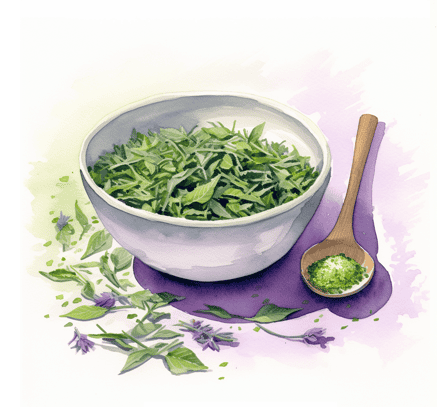
Ever wondered, is tea acidic or basic, and how that impacts your busy, beauty-conscious lifestyle? Let’s dive into how the type of tea you’re drinking could impact your health and beauty. Because understanding the pH of tea is more than just chemistry; it’s about ensuring every sip contributes to your goals.
Hi, I’m Hazel
I gave up on skincare after years of issues with acne and sensitive skin.
But after going plant-based, my skin cleared up and even started to glow. Now I help women reveal their natural beauty with simple, delicious plant-based food.
I also used to be a nurse, and love nerding out on nutritional science (high-quality science, that is).

As usual, this post is based on the strongest nutritional evidence I could find with a focus on the simplest, most delicious foods
…because who has time to waste on actions that don’t work?
The quick version:
Most teas are mildly acidic, with pH values typically ranging between 4 and 7. The acidity depends on the type of tea, with black tea being the most acidic and herbal teas like chamomile and hibiscus being closer to neutral.
How Diet Acidity Impacts Your Skin
Maintaining a diet low in acidity is crucial for both overall health and skin condition.
Consuming foods that lead to high acidity in the body can trigger inflammation and oxidative stress. This is linked with various skin issues such as redness, swelling, and irritation and prematurely age your skin (1, 2, 3, 4).

Furthermore, the type of diet you follow can directly affect your skin’s pH and oil production.
A diet that consists of a high intake of meats, dairy, and alcohol, typically leads to more acidic skin. This condition is associated with increased sebum production, which can exacerbate skin issues like acne and oiliness (5).
If you’re concerned about skin health, it’s better to incorporate more alkaline foods, such as fruits and vegetables, into your diet. These foods can help balance the body’s pH, reduce inflammation, and support clearer, healthier-looking skin.
By making these dietary choices, you not only enhance your health but also contribute to lasting beauty and well-being.
Why Tea Acidity Matters
Understanding how each cup of tea affects your body is crucial for maintaining not only digestive comfort but also for supporting overall health.

Potential health benefits include:
Gentler on Your Stomach
Compared to other acidic beverages like fruit juices and soft drinks, tea is generally less harsh on the stomach. However, the acidity can still impact those with sensitive digestive systems or those prone to acid reflux.
Gentler on Your Teeth
While tea is less damaging than some other acidic drinks, frequent consumption of highly acidic teas can still pose a risk to tooth enamel (6). Opting for less acidic teas can help minimise this risk.
Natural Antioxidants
Although acidity in tea can vary, all teas contain natural antioxidants which help neutralise free radicals—unstable molecules that can damage cells. These result in anti-inflammatory properties which are beneficial regardless of a tea’s acidity level and contribute to heart health and improve brain function.
Tea Talk: What Does pH Even Mean?
Tea is a beloved ritual for many, but its impact goes beyond taste; it’s how the level of acidity that can affect your body.
Acidity refers to how sour or sharp something tastes and is measured on a scale called the pH scale.
The pH scale ranges from 0 to 14. Things with a lower pH (below 7) are acidic, those around 7 are neutral, like water, and those above 7 are basic (or alkaline).
In terms of everyday experience, acidic substances tend to have a tart or sharp flavour, like lemon juice or vinegar.
Most types of tea lean towards the acidic side, which might surprise those of us minding our skin’s glow and digestive harmony.
Knowing the pH levels of tea helps in choosing the right brew to maintain the delicate balance your body craves.
Ranking Teas by Acidity

Wondering if your favourite cuppa is an acidic tea? Here’s a quick guide from the most to the least acidic, helping you make an informed choice:
Black Tea
The most acidic, with a pH ranging from 4.5 to 5 (6). This makes it a robust choice but one that might be harsher on sensitive stomachs and skin, especially on an empty stomach.
Oolong Tea
Moderately acidic, holding a pH value between 5 and 6. It offers a smoother taste with slightly less impact on acidity-related discomfort.
Green Tea
Known for its health benefits, the acidity of green tea is mild, with a pH hovering around 6 to 7, making it a safer option for those concerned with acidity.
White Tea and Herbal Teas
These teas are the gentlest on the pH scale (7).
Typically near neutral, they include soothing varieties like chamomile tea and hibiscus tea, which are excellent for night-time routines and those with highly sensitive skin or digestive systems.
From Tangy to Tame: Finding Your Tea Type
Choosing the right tea for your daily routine can enhance your health and align with your dietary preferences.
Here are some practical tips to integrate the right teas into your lifestyle:
After-Meal Calm
If you’ve just had a meal high in acidic foods like tomatoes, citrus fruits, or processed meats, choosing a tea with lower acidity can help balance your stomach’s pH. Choose herbal teas to neutralise the acid from your last meal—think chamomile, hibiscus, or ginger.
Tea Lovers Wanting a Daily Dose
Embrace the gentle nature of white and green teas for your daily tea ritual. White tea and green tea are excellent choices for regular consumption due to their milder acidity and high antioxidant properties.

Flavour Meets Health
If you’re looking for health benefits along with great taste, explore the colourful world of fruit teas—low in acid, high in taste and wellness benefits.
What Makes Your Tea More Acidic?
Wondering what makes your favourite cup of tea more or less acidic?
Here are the main factors that determine the acidity of tea, allowing you to tweak your tea habits for better health outcomes:
Processing: The way tea is processed plays a significant role in its final acidity. Fermentation and oxidation processes, which are used to produce black tea and oolong tea, typically increase the acidity. This contrasts with the minimal processing of green tea and white tea, which helps retain their lower acidity levels.
Environment: The conditions under which tea leaves are grown can significantly influence their acidity. Factors like soil type, altitude, and climate conditions can alter the chemical composition of tea leaves, affecting their natural acidity.
Brewing: How you brew your tea can also impact its acidity.
Tea bags often contain finer leaves, which allow for quicker and more intense extraction of acidic components.
Loose leaf tea, which releases flavours and acids more slowly and gently. Adjusting brewing time and temperature can help control the acidity level, making your tea more palatable and stomach-friendly.
Is tea acidic or basic?
As we’ve explored whether is tea acidic or basic, it’s clear that the right choice of tea can have a significant impact on both health and enjoyment. From the soothing effects of herbal blends to the invigorating punch of black tea, there’s a type to fit every moment of your day. Experiment with different types of tea to discover what best supports your beauty and wellness goals. Embrace the journey of tea tasting, and let each cup of tea bring you closer to achieving the perfect balance in your health-conscious lifestyle.
References
Most references below will link to the original peer-reviewed study itself. However, sometimes I will link to a video over at NutritionFacts.org instead, which is by far the single best resource of brutally transparent nutritional evidence you will ever see. Dr Greger tells a great story about the realities of the science and if I think you will benefit more from one of his videos, the link will take you there instead.
Happy nerding!
- Wu T, Seaver P, Lemus H, Hollenbach K, Wang E, Pierce JP. Associations between Dietary Acid Load and Biomarkers of Inflammation and Hyperglycemia in Breast Cancer Survivors. Nutrients. 2019;11(8):1913. Published 2019 Aug 15. doi:10.3390/nu11081913
- Öteleş S, Ayan G, Ekici M, Ünal E, Bilgiç P, Kalyoncu U. The dietary acid load is associated with disease severity in psoriatic arthritis (PsA). Mod Rheumatol. Published online November 10, 2023. doi:10.1093/mr/road107
- Balali A, Nehls MS, Tabibi H, As’habi A, Arab A. Dietary acid load and markers of malnutrition, inflammation, and oxidative stress in hemodialysis patients. Front Nutr. 2024;11:1369206. Published 2024 Mar 22. doi:10.3389/fnut.2024.1369206
- Baechle JJ, Chen N, Makhijani P, Winer S, Furman D, Winer DA. Chronic inflammation and the hallmarks of aging. Mol Metab. 2023;74:101755. doi:10.1016/j.molmet.2023.101755
- Lim S, Shin J, Cho Y, Kim KP. Dietary Patterns Associated with Sebum Content, Skin Hydration and pH, and Their Sex-Dependent Differences in Healthy Korean Adults. Nutrients. 2019;11(3):619. Published 2019 Mar 14. doi:10.3390/nu11030619
- Simpson A, Shaw L, Smith AJ. Tooth surface pH during drinking of black tea. Br Dent J. 2001;190(7):374-376. doi:10.1038/sj.bdj.4800977
- Phelan J, Rees J. The erosive potential of some herbal teas. J Dent. 2003;31(4):241-246. doi:10.1016/s0300-5712(03)00048-4